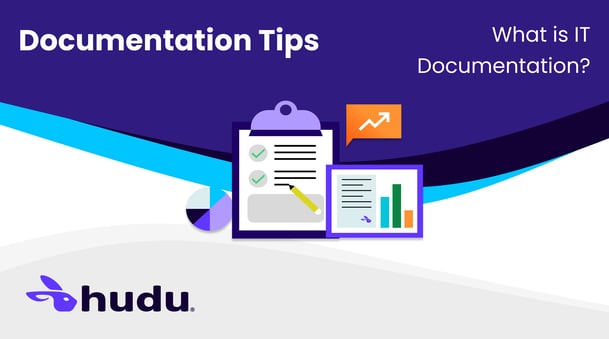

What Is IT Documentation?
Imagine you have a big box of LEGOs.
Now, pretend your job is to build a really cool castle with those LEGOs.
You do it once, and it looks amazing! But the next day, your friend wants to build the same castle.
Uh-oh… you forgot how you built it!
IT documentation is like a set of instructions you write down so that you (or your friends) can build the same LEGO castle again anytime - without guessing.
In the real world, instead of LEGO castles, grown-ups build computers, networks, and websites. So, they write down what they did, how it works, and how to fix it if it breaks.
It’s like a giant instruction book for everything in your tech toybox.
Whether you're running an internal IT department or an MSP managing dozens of environments, having strong documentation isn't optional - it’s essential.
Why does IT Documentation matter?
Without documentation, knowledge lives in people’s heads (until they leave). You risk inconsistent support, slower onboarding, longer resolution times, and costly mistakes.
With good documentation, you gain:
- Faster technician onboarding
- Quicker resolution of tickets
- Better client service and trust
- Easier compliance with frameworks like HIPAA, SOC 2, and more
- Greater operational consistency across teams
Strong IT documentation transforms individual knowledge into shared assets, driving faster onboarding, smoother support, higher client confidence, regulatory compliance, and consistent team performance.
What should be documented?
IT documentation covers a wide range of areas, and Hudu is built to support the ones that matter most and a whole lot more:
1. Client and company info
Details like locations, points of contact, and key dates are the foundation. Hudu’s Company Overview makes this data easy to find and maintain.
2. IT assets
Think: servers, workstations, firewalls, and cloud resources. Using custom asset layouts, you can structure your asset documentation to match exactly how your team works - no rigid templates.
3. Passwords and credentials
Securely store and share credentials with built-in Password Management. Role-based permissions ensure access is tightly controlled and auditable.
4. Processes and SOPs
Step-by-step documentation for repeatable tasks is critical for scaling your team. Use Processes and Knowledge Base articles in Hudu to capture tribal knowledge and standardize how work gets done.
5. Integrations with key tools
Documentation shouldn’t live in a vacuum. Hudu connects with tools like Microsoft 365, HaloPSA, ConnectWise, and more, automatically syncing vital information and reducing duplicate entry.
6. Compliance and security records
Need to maintain logs or show controls for HIPAA or SOC 2? Hudu helps centralize documentation for policies, audits, and IT best practices, so you're not scrambling when the auditor shows up.
What makes good IT Documentation?
It’s not just about writing things down. Effective documentation is:
- Structured: Use consistent templates and formats
- Searchable: Quickly find what you need with smart search tools
- Up-to-date: Built-in reminders and assignments help prevent rot
- Secure: Permission controls and version history protect sensitive data
- Collaborative: Let your team contribute, but with controls in place
- Accessible: Available on desktop, mobile, and via browser extension
Effective IT documentation balances clarity, security, and accessibility - ensuring your team can easily find, trust, and contribute to up-to-date information anytime, anywhere.
Why do you still need IT Documentation - even if you use a PSA and RMM tool?
If you're already using a PSA (Professional Services Automation) and RMM (Remote Monitoring & Management) tool, you're ahead of the game. But there's a critical piece many IT teams overlook: documentation.
But what if your PSA or RMM includes documentation? Here’s why even the best PSA and RMM stacks fall short and how an IT documentation software fills the gaps.
What’s the difference?
Think of your PSA, RMM, and Documentation platform as the three pillars of a mature, scalable IT operation:

Real-world gaps a PSA & RMM can’t cover
Here’s where a dedicated documentation platform makes a big impact.
Configuration context
- RMMs show you the status of a device.
- Documentation shows why it’s configured that way, what it connects to, and what to do when it breaks.
Repeatable workflows
- PSAs track that a task got done.
- Documentation shows how to do it again correctly every time.
Faster technician ramp-up
- Without documentation, new hires rely on tribal knowledge or ticket spelunking.
- With documentation, they’re productive in days, not months.
Client trust & transparency
- Impress clients with organized, consistent, and secure records of their environment.
- Use documentation to show your value beyond ticket resolution.
What each tool typically covers

The bottom line
Your PSA and RMM are critical, but they’re not your brain. IT documentation is.
It’s the difference between “we fixed it” and “we know it.”
If you want to run a more scalable, profitable, and stress-free operation, documentation isn't optional - it’s your competitive edge.
How Hudu helps
Hudu is purpose-built IT documentation software for MSPs and internal IT teams. We give you the tools to:
- Organize information intuitively with custom layouts
- Share knowledge securely via permissions and audit trails
- Create documentation faster with tools like Screen Capture
- Access documentation anywhere using our browser extension or mobile app
- Automate updates with integrations to your tech stack
- Deploy flexibly with either cloud-hosted or self-hosted options
If you’re tired of scattered spreadsheets, tribal knowledge, and lost time, it might be time for a better way to document.
More from Hudu...
View All PostsSubscribe to Our Blog
Stay up-to-date on all Hudu happenings including releases and articles.

